ART NEWS: Oct.01
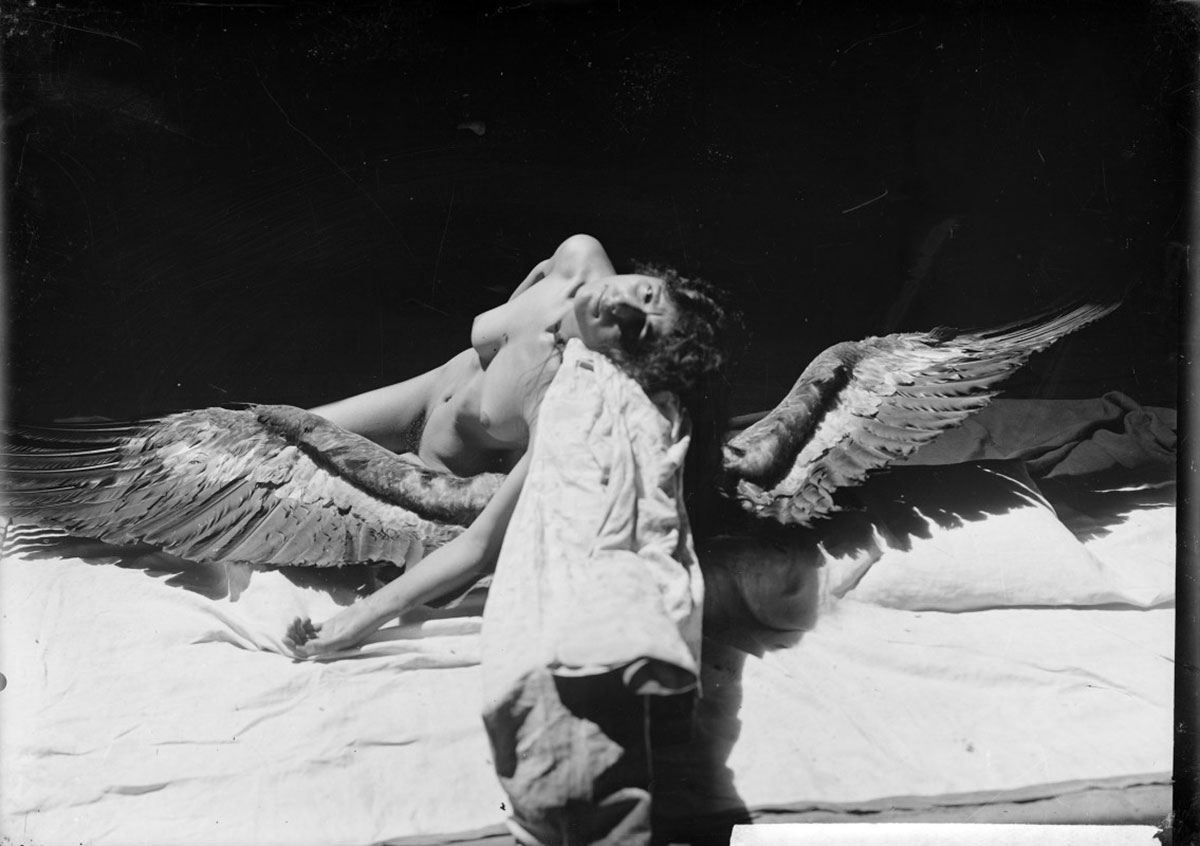 The exhibition “The Avant-Garde in Georgia (1900-1936)”, presents, for the very first time in Europe, a largely forgotten chapter in the history of avant-garde art. The Georgian avant-garde is shown and contextualised through a large body of works (paintings, drawings, films, photographs and decors as well as costumes from films and theatre plays) mainly kept in Georgia. In the aftermath of the fall of the Russian Empire and the October Revolution, in a turbulent world context, Georgia declared its independence in 1918. This brief, enchanted interlude ended with the Soviet invasion of 1921. Nevertheless, it allowed for an abundant and inspiring avant-garde creation to flourish. Artists developed new artistic practices that redefined a general attitude to life, which took many forms and combined Georgian traditions with Eastern and Western influences. They interacted in paintings, drawings, writing, films, photographs, performances, typographic research, books and plays. Movements as diverse as (neo-)Symbolism, Futurism, Dadaism, Zaum, Everythingism, Expressionism, Cubism and Cubo-Futurism coexisted in an unprecedented creative ferment. The year 1936 and the great purges ordered by Stalin’s regime marked the end of Georgian avant-garde creation, but the ideas persisted down the generations and resurfaced in the 1970s. Info: Curators: Nana Kipiani, Irine Jorjadze and Tea Tabatadze, BOZAR Centre for Fine Arts, Rue Ravensteinstraat 23, Brussels, Belgium, Duration: 5/10/2023-24/1/2024, Days & Hours: Tue-Sun 10:00-8:00, www.bozar.be/en
The exhibition “The Avant-Garde in Georgia (1900-1936)”, presents, for the very first time in Europe, a largely forgotten chapter in the history of avant-garde art. The Georgian avant-garde is shown and contextualised through a large body of works (paintings, drawings, films, photographs and decors as well as costumes from films and theatre plays) mainly kept in Georgia. In the aftermath of the fall of the Russian Empire and the October Revolution, in a turbulent world context, Georgia declared its independence in 1918. This brief, enchanted interlude ended with the Soviet invasion of 1921. Nevertheless, it allowed for an abundant and inspiring avant-garde creation to flourish. Artists developed new artistic practices that redefined a general attitude to life, which took many forms and combined Georgian traditions with Eastern and Western influences. They interacted in paintings, drawings, writing, films, photographs, performances, typographic research, books and plays. Movements as diverse as (neo-)Symbolism, Futurism, Dadaism, Zaum, Everythingism, Expressionism, Cubism and Cubo-Futurism coexisted in an unprecedented creative ferment. The year 1936 and the great purges ordered by Stalin’s regime marked the end of Georgian avant-garde creation, but the ideas persisted down the generations and resurfaced in the 1970s. Info: Curators: Nana Kipiani, Irine Jorjadze and Tea Tabatadze, BOZAR Centre for Fine Arts, Rue Ravensteinstraat 23, Brussels, Belgium, Duration: 5/10/2023-24/1/2024, Days & Hours: Tue-Sun 10:00-8:00, www.bozar.be/en
 Dash’s new paintings in the exhibition “and Water” highlight some of the artist’s most significant aesthetic and conceptual approaches: harnessing the interaction of earth and water to create vertical topographical fields of desiccated mud; layering commercial printing technology onto the paintings’ prepared grounds; and arranging readymade found objects and industrial detritus—water bottles, agricultural netting, architectural insulation—alongside natural materials. Dash’s “fabric sculptures,” diminutive forms created when the artist rubs pieces of cloth to the point of disintegration, also appear in these works as silkscreened images. These idiosyncratic, somatic sculptures are potent emblems of entropy, complexity, and change. Dash’s work draws from a deep connection to the land and an awareness of environmental and material transformations. Often beginning with troweled base layers of excavated earth, the artist then aggregates numerous materials and processes on these grounds to create complex visual terrains. Works on view in and Water feature expanses of graphite burnished to radiance; strata of earth cut through by lengths of string, and layers of silkscreen ink that reproduce color fields of rosettes—a visual artifact resembling floral blooms formed during the mechanical halftone printing process—as well as images of Dash’s fabric sculptures enlarged to monumental proportions. Info: SITE Santa Fe, 1606 Paseo de Peralta, Santa Fe, NM, USA, Duration: 6/10/2023-5/2/2024, Days & Hours: Mon-Thu & Sat-sun 10:00-17:00, Fri 10:00-19:00, https://sitesantafe.org/
Dash’s new paintings in the exhibition “and Water” highlight some of the artist’s most significant aesthetic and conceptual approaches: harnessing the interaction of earth and water to create vertical topographical fields of desiccated mud; layering commercial printing technology onto the paintings’ prepared grounds; and arranging readymade found objects and industrial detritus—water bottles, agricultural netting, architectural insulation—alongside natural materials. Dash’s “fabric sculptures,” diminutive forms created when the artist rubs pieces of cloth to the point of disintegration, also appear in these works as silkscreened images. These idiosyncratic, somatic sculptures are potent emblems of entropy, complexity, and change. Dash’s work draws from a deep connection to the land and an awareness of environmental and material transformations. Often beginning with troweled base layers of excavated earth, the artist then aggregates numerous materials and processes on these grounds to create complex visual terrains. Works on view in and Water feature expanses of graphite burnished to radiance; strata of earth cut through by lengths of string, and layers of silkscreen ink that reproduce color fields of rosettes—a visual artifact resembling floral blooms formed during the mechanical halftone printing process—as well as images of Dash’s fabric sculptures enlarged to monumental proportions. Info: SITE Santa Fe, 1606 Paseo de Peralta, Santa Fe, NM, USA, Duration: 6/10/2023-5/2/2024, Days & Hours: Mon-Thu & Sat-sun 10:00-17:00, Fri 10:00-19:00, https://sitesantafe.org/
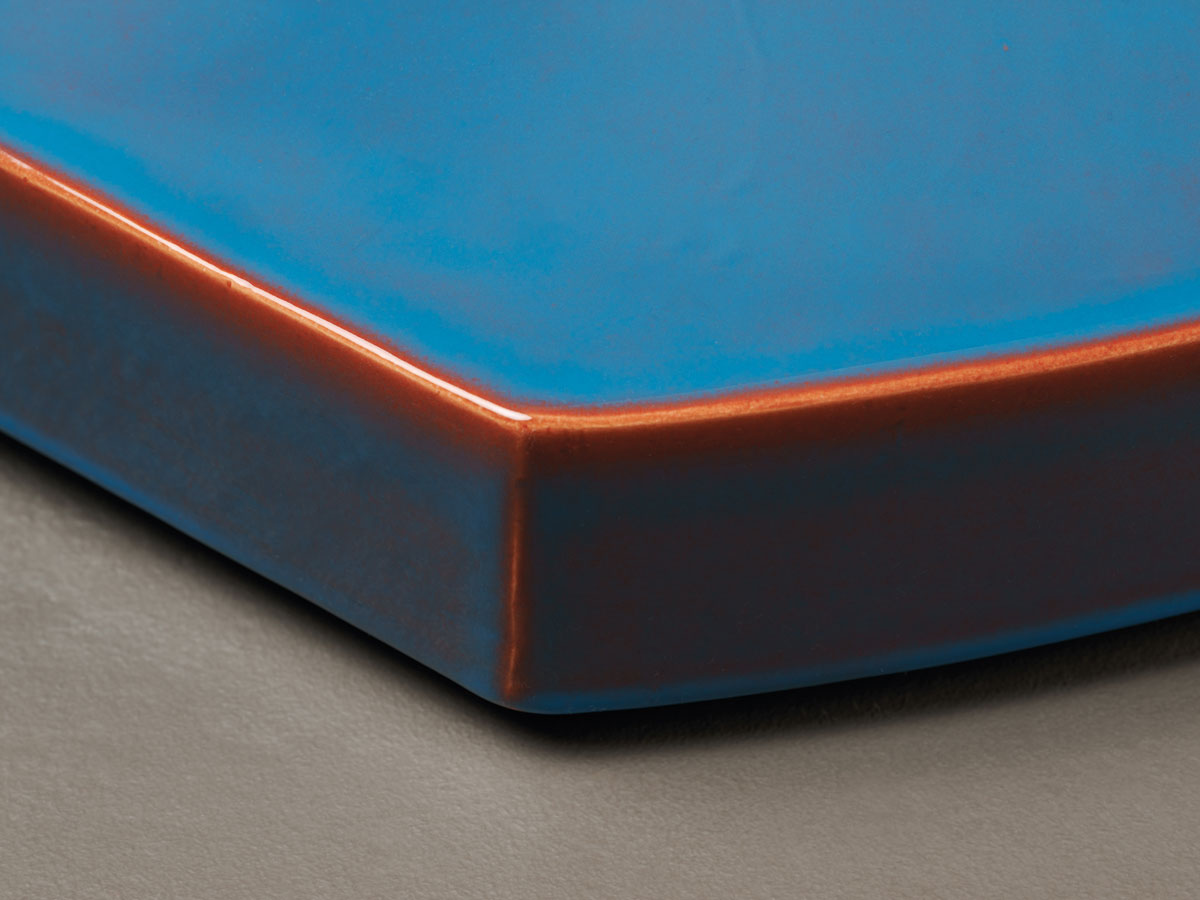 In his exhibition “Tread”, Richard Deacon presents sculptures from six groups of works, each characterised by the distinct use of a different material, ranging from steamed wood to glazed ceramic to stainless steel. The sculptures are invariably marked by the artist’s experiments with diverse materials and his deep-rooted interest in their specific consistencies and qualities. Deacon remains faithful to the principles of craftsmanship that have driven his practice since the beginning of his career and constitute an integral part of his aesthetic. Among his most recent works are a group of small-scale ceramic sculptures, a medium Deacon has been associated with for over 20 years. Marked by their shiny, glass-smooth finish, these works manifest the artist’s preoccupation with surface, form and color. The polygonal shapes are accentuated by prominently colored rims, some of which have been rendered in contrasting hues. The final effect of the glazed surfaces is only revealed after the firing process, introducing an element of chance to his practice, otherwise usually governed by control. Info: Thaddaeus Ropac Gallery, Mirabellplatz 2, Salzburg, Austria, Duration: 7/10-23/12/2023, Days & Hours: Tue-Fri 10:00-18:00, Sat 10:00-14:00, https://ropac.net/
In his exhibition “Tread”, Richard Deacon presents sculptures from six groups of works, each characterised by the distinct use of a different material, ranging from steamed wood to glazed ceramic to stainless steel. The sculptures are invariably marked by the artist’s experiments with diverse materials and his deep-rooted interest in their specific consistencies and qualities. Deacon remains faithful to the principles of craftsmanship that have driven his practice since the beginning of his career and constitute an integral part of his aesthetic. Among his most recent works are a group of small-scale ceramic sculptures, a medium Deacon has been associated with for over 20 years. Marked by their shiny, glass-smooth finish, these works manifest the artist’s preoccupation with surface, form and color. The polygonal shapes are accentuated by prominently colored rims, some of which have been rendered in contrasting hues. The final effect of the glazed surfaces is only revealed after the firing process, introducing an element of chance to his practice, otherwise usually governed by control. Info: Thaddaeus Ropac Gallery, Mirabellplatz 2, Salzburg, Austria, Duration: 7/10-23/12/2023, Days & Hours: Tue-Fri 10:00-18:00, Sat 10:00-14:00, https://ropac.net/
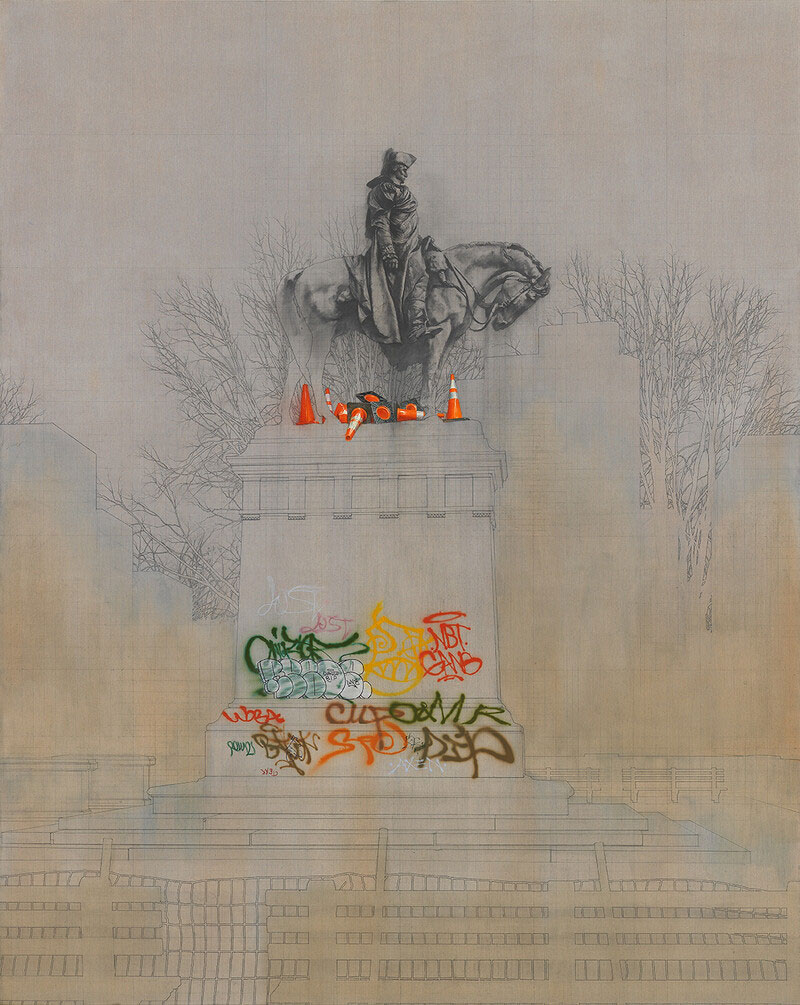 “May 25th, 2020” is the title of the first UK institutional exhibition by Esteban Jefferson. Jefferson’s practice critiques legacies of colonialism and racism as encoded in museum displays and public artworks. He will create a new series of works for the exhibition revolving around the detritus from public displays of protest related to the death of George Floyd. Through repeated visits to sites of protest, from small interventions like graffiti on a bus stop sign to large-scale vandalism of well-known colonialist monuments, Jefferson tracks the lifespan of the protests that erupted in 2020. Additional works in the show depict the Theodore Roosevelt Memorial statue that was positioned outside the American Museum of Natural History in New York until 2022. The statue features Roosevelt on horseback, flanked on each side by a Native American and Black man at his feet. The statue had been the focus of a sustained campaign of criticism for years and was finally removed, but not destroyed, in January 2022. The sculpture has since been relocated to the Theodore Roosevelt Presidential Library in North Dakota (out of sight, out of mind). Info: Goldsmiths CCA, St James, New Cross, London, United Kingdom, Duration: 7/10/2023-24/1/2024, Days & Hours: Wed-Sun 12:00-18:00, https://goldsmithscca.art/
“May 25th, 2020” is the title of the first UK institutional exhibition by Esteban Jefferson. Jefferson’s practice critiques legacies of colonialism and racism as encoded in museum displays and public artworks. He will create a new series of works for the exhibition revolving around the detritus from public displays of protest related to the death of George Floyd. Through repeated visits to sites of protest, from small interventions like graffiti on a bus stop sign to large-scale vandalism of well-known colonialist monuments, Jefferson tracks the lifespan of the protests that erupted in 2020. Additional works in the show depict the Theodore Roosevelt Memorial statue that was positioned outside the American Museum of Natural History in New York until 2022. The statue features Roosevelt on horseback, flanked on each side by a Native American and Black man at his feet. The statue had been the focus of a sustained campaign of criticism for years and was finally removed, but not destroyed, in January 2022. The sculpture has since been relocated to the Theodore Roosevelt Presidential Library in North Dakota (out of sight, out of mind). Info: Goldsmiths CCA, St James, New Cross, London, United Kingdom, Duration: 7/10/2023-24/1/2024, Days & Hours: Wed-Sun 12:00-18:00, https://goldsmithscca.art/
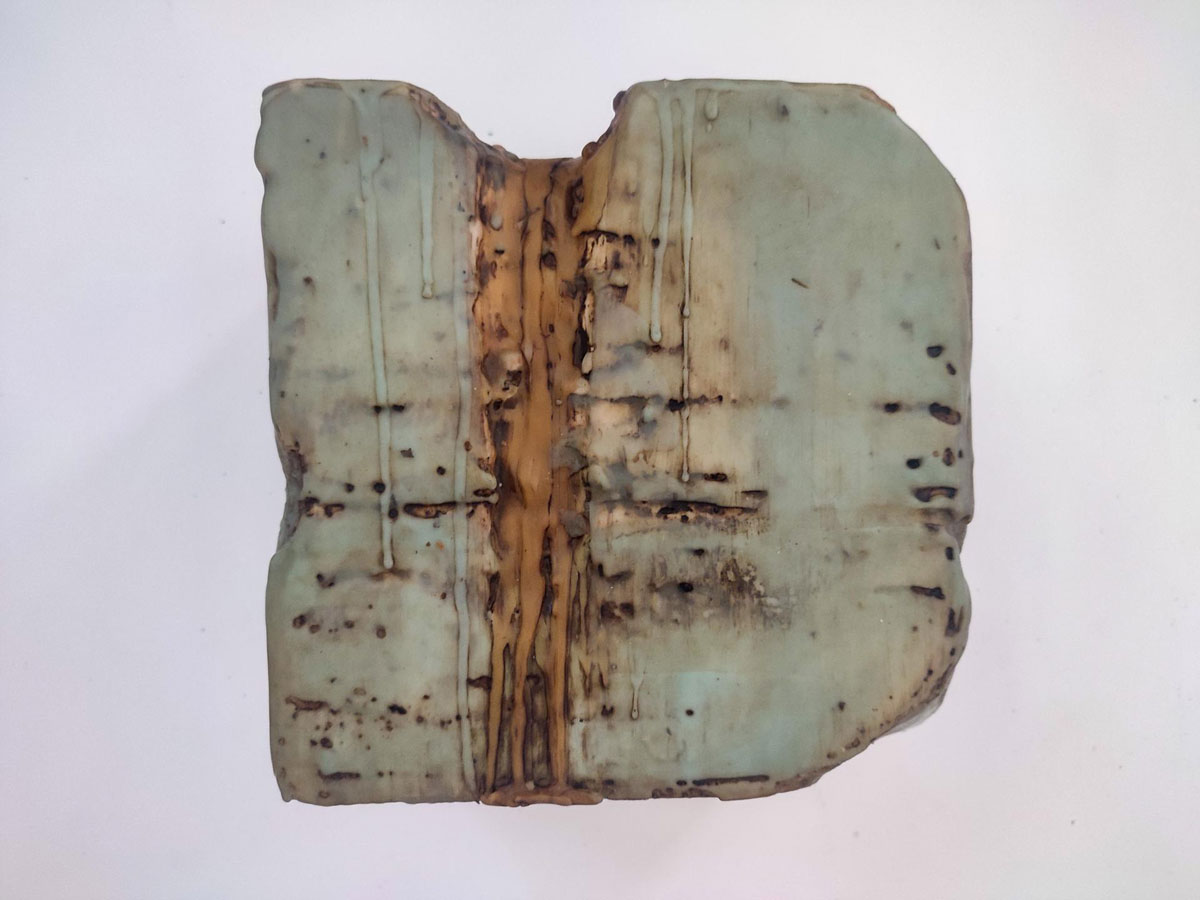 The core themes of Silvia Infranco’s exhibition “Viridis” are the relationship between time and memory, the relationship between art and science and the close connection between the objective investigation of the natural world and the ontological reflection with a strong spiritual imprint. Silvia Infranco’s project focuses on the relationship of the man with the nature, in the context of the phytotherapeutic approach. It emphasize its symbolic and alchemic implications, typical of archaic healing processes in which language was part of a rituality aimed at enhancing the thaumaturgic power of plants in order to obtain the patient’s recovery. Following extensive and meticulous research carried out by the artist on ancient manuscripts and printed texts (from herbals to the pharmacopeia accompanied by orations activating the phytotherapeutic power), the artworks evoke a continuity between a “magical” past and a “technical-experimental” modernity, suggesting new forms of interpretation and conciliation between apparently distant worlds. Info: Curator: Marina Dacci, Galleria Marignana Arte, Dorsoduro, 141, Rio Terà dei Catecumeni, Venice, Italy, Duration: 7/10-16/12/2024, Days & Hours: Wed-Sat 11:00-19:00, www.marignanaarte.it/
The core themes of Silvia Infranco’s exhibition “Viridis” are the relationship between time and memory, the relationship between art and science and the close connection between the objective investigation of the natural world and the ontological reflection with a strong spiritual imprint. Silvia Infranco’s project focuses on the relationship of the man with the nature, in the context of the phytotherapeutic approach. It emphasize its symbolic and alchemic implications, typical of archaic healing processes in which language was part of a rituality aimed at enhancing the thaumaturgic power of plants in order to obtain the patient’s recovery. Following extensive and meticulous research carried out by the artist on ancient manuscripts and printed texts (from herbals to the pharmacopeia accompanied by orations activating the phytotherapeutic power), the artworks evoke a continuity between a “magical” past and a “technical-experimental” modernity, suggesting new forms of interpretation and conciliation between apparently distant worlds. Info: Curator: Marina Dacci, Galleria Marignana Arte, Dorsoduro, 141, Rio Terà dei Catecumeni, Venice, Italy, Duration: 7/10-16/12/2024, Days & Hours: Wed-Sat 11:00-19:00, www.marignanaarte.it/
 Manuel Mathieu is known for vibrant, coloful paintings that seamlessly merge abstraction with figuration. His work reflects on our intertwined lives, in which the boundaries between the past and present or the personal and political are often blurred. Sharing recollections that depict everyday scenes, Mathieu also blends into his canvases an interrogation of the complex history of his familial homeland, Haiti. By unearthing the traumas of state violence, he addresses issues that remain as urgent today as they have been throughout Haitian history. The exhibition “World Discovered Under Other Skies” features a collection of new and past works shedding light on Haiti’s relationship to the world. Positioned at the fault lines of modern political and environmental crises, Haiti epitomizes a global longing for liberation and grassroots resistance to imperialist and capitalist exploits. At the centre of this exhibition is an examination of the long-lasting repercussions of Haiti’s pioneering revolt, in 1791, challenging slavery and colonialism—and its quest for self-determination, which have led in more recent decades to embroiling the nation in the intrigues of the Cold War. Info: Curator: Amin Alsaden, Owens Art Gallery at Mount Allison University, 61 York Street, Sackville, New Brunswick, Canada, Duration: 7/10-10/12/2023, Days & Hours: Mon-Fri 10:00-17:00, Sat-Sun 13:00-17:00, https://owensartgallery.com/
Manuel Mathieu is known for vibrant, coloful paintings that seamlessly merge abstraction with figuration. His work reflects on our intertwined lives, in which the boundaries between the past and present or the personal and political are often blurred. Sharing recollections that depict everyday scenes, Mathieu also blends into his canvases an interrogation of the complex history of his familial homeland, Haiti. By unearthing the traumas of state violence, he addresses issues that remain as urgent today as they have been throughout Haitian history. The exhibition “World Discovered Under Other Skies” features a collection of new and past works shedding light on Haiti’s relationship to the world. Positioned at the fault lines of modern political and environmental crises, Haiti epitomizes a global longing for liberation and grassroots resistance to imperialist and capitalist exploits. At the centre of this exhibition is an examination of the long-lasting repercussions of Haiti’s pioneering revolt, in 1791, challenging slavery and colonialism—and its quest for self-determination, which have led in more recent decades to embroiling the nation in the intrigues of the Cold War. Info: Curator: Amin Alsaden, Owens Art Gallery at Mount Allison University, 61 York Street, Sackville, New Brunswick, Canada, Duration: 7/10-10/12/2023, Days & Hours: Mon-Fri 10:00-17:00, Sat-Sun 13:00-17:00, https://owensartgallery.com/
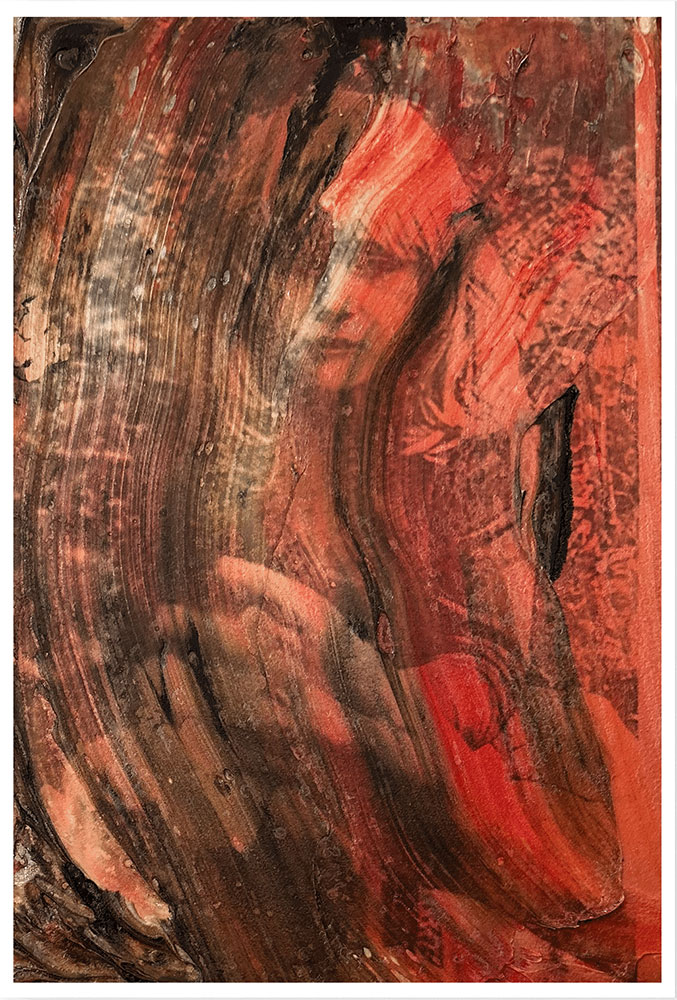 In direct comparison to the advanced technology and monumental ambition of his recent large installations such as PLAY, for the exhibition “Flea Circus” in London Urs Fischer has initiated experiments in a very different register. The new body of work is modest in scale and predominantly analogue in production. In a low-fi darkroom in his studio, small paintings are coated with exposure emulsion to receive layer upon layer of photographic images, resulting in a surprising unpredictability for both the artist and viewer. The source images are snapshots of the box-under-the-bed kind, memories of family ancestry and personal biography, which morph into unexpected hybrids recalling the ghostly spiritual apparitions of Victorian photography. Faces are pulled out of the ether to propose cloudy memories of looped familial relationships, the like of which every person has, with the analogue qualities emphasising our sense of the imperfect match of historical document with actual memory. Info: Sadie Coles HQ, 8 Bury Street, London, United Kingdom, Duration: 7/10-18/11/2023, Days & Hours: Tue-Sat 11:00-18:00, www.sadiecoles.com/
In direct comparison to the advanced technology and monumental ambition of his recent large installations such as PLAY, for the exhibition “Flea Circus” in London Urs Fischer has initiated experiments in a very different register. The new body of work is modest in scale and predominantly analogue in production. In a low-fi darkroom in his studio, small paintings are coated with exposure emulsion to receive layer upon layer of photographic images, resulting in a surprising unpredictability for both the artist and viewer. The source images are snapshots of the box-under-the-bed kind, memories of family ancestry and personal biography, which morph into unexpected hybrids recalling the ghostly spiritual apparitions of Victorian photography. Faces are pulled out of the ether to propose cloudy memories of looped familial relationships, the like of which every person has, with the analogue qualities emphasising our sense of the imperfect match of historical document with actual memory. Info: Sadie Coles HQ, 8 Bury Street, London, United Kingdom, Duration: 7/10-18/11/2023, Days & Hours: Tue-Sat 11:00-18:00, www.sadiecoles.com/
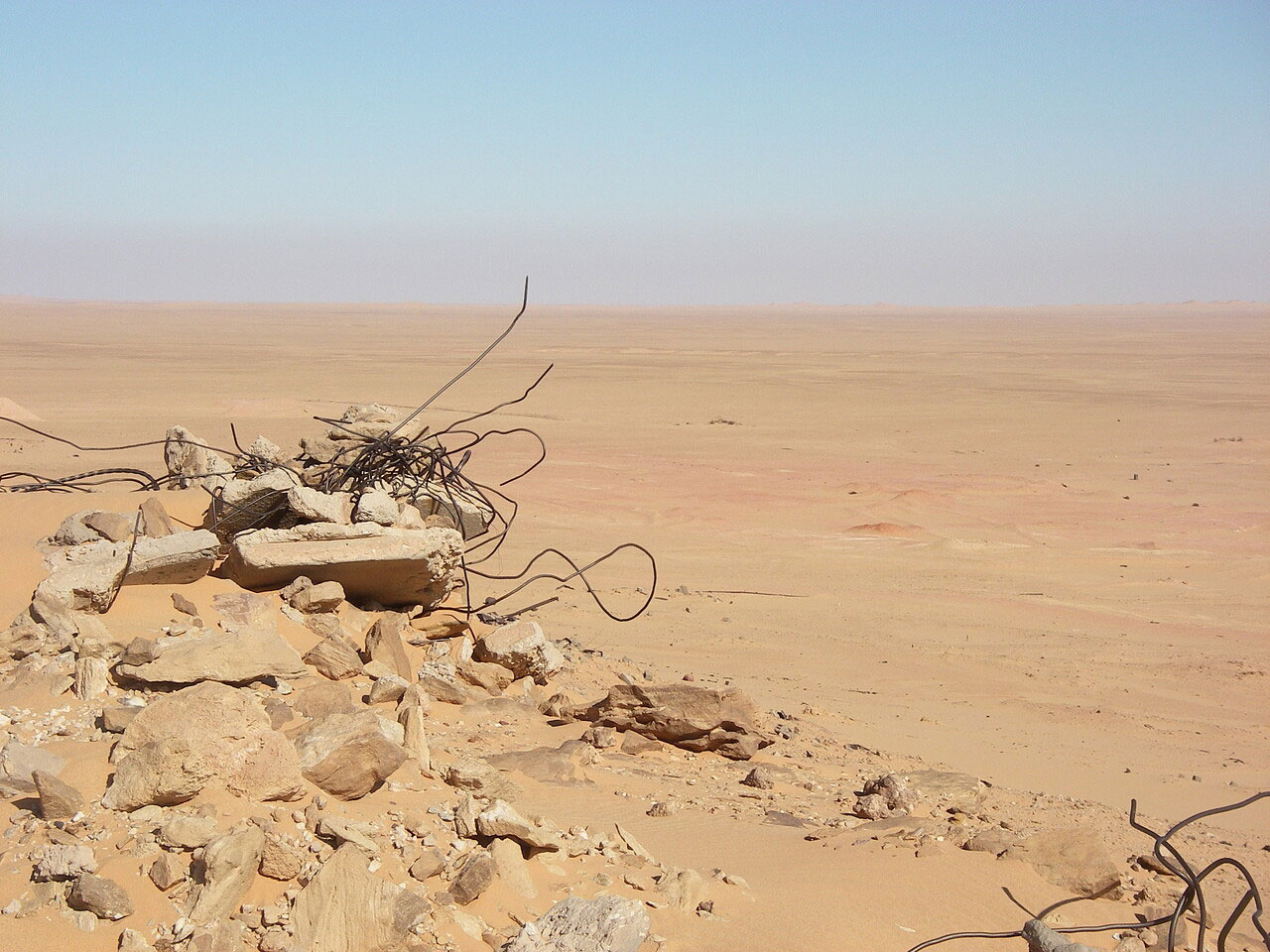 Between 1960 and 1966, the French colonial regime detonated four atmospheric atomic bombs, thirteen underground nuclear bombs and conducted other nuclear experiments in the Algerian Sahara, whose natural resources were being extracted in the process. This secret nuclear weapons programme occurred during and after the Algerian War of Independence (1954–62). The resulting toxification of the Sahara spread radioactive fallout across Algeria, North, Central and West Africa, and the Mediterranean causing irreversible and still ongoing contaminations of living bodies, cells and particles, as well as in the natural and built environments. Because the archives of the French nuclear programme remain closed over fifty years later, historical details and continuing impacts remain largely unknown. The exhibition “Performing Colonial Toxicity” presents available, offered, contraband and leaked materials from these archives in an immersive multimedia installation. It creates with them a series of audio-visual assemblages, which trace the spatial, atmospheric, and geological impacts of France’s atomic bombs in the Sahara, as well as its colonial vocabularies, and the (after)lives of its radioactive debris and nuclear waste. Taking on an architectural scale, these “stations”, as Henni refers to them, are meant to be moved through and engaged with. Visitors are invited in to draw their own connections between what is present in the installation, as well as what is absent from it. Info: Researcher: Samia Henni, Curator: Megan Hoetger, Framer Framed, Oranje-Vrijstaatkade 71, Amsterdam, The Netherlands, Duration: 8/10/203-24/1/2024, Days & Hours: Tue-Sun 12:00-18:00, https://framerframed.nl/
Between 1960 and 1966, the French colonial regime detonated four atmospheric atomic bombs, thirteen underground nuclear bombs and conducted other nuclear experiments in the Algerian Sahara, whose natural resources were being extracted in the process. This secret nuclear weapons programme occurred during and after the Algerian War of Independence (1954–62). The resulting toxification of the Sahara spread radioactive fallout across Algeria, North, Central and West Africa, and the Mediterranean causing irreversible and still ongoing contaminations of living bodies, cells and particles, as well as in the natural and built environments. Because the archives of the French nuclear programme remain closed over fifty years later, historical details and continuing impacts remain largely unknown. The exhibition “Performing Colonial Toxicity” presents available, offered, contraband and leaked materials from these archives in an immersive multimedia installation. It creates with them a series of audio-visual assemblages, which trace the spatial, atmospheric, and geological impacts of France’s atomic bombs in the Sahara, as well as its colonial vocabularies, and the (after)lives of its radioactive debris and nuclear waste. Taking on an architectural scale, these “stations”, as Henni refers to them, are meant to be moved through and engaged with. Visitors are invited in to draw their own connections between what is present in the installation, as well as what is absent from it. Info: Researcher: Samia Henni, Curator: Megan Hoetger, Framer Framed, Oranje-Vrijstaatkade 71, Amsterdam, The Netherlands, Duration: 8/10/203-24/1/2024, Days & Hours: Tue-Sun 12:00-18:00, https://framerframed.nl/
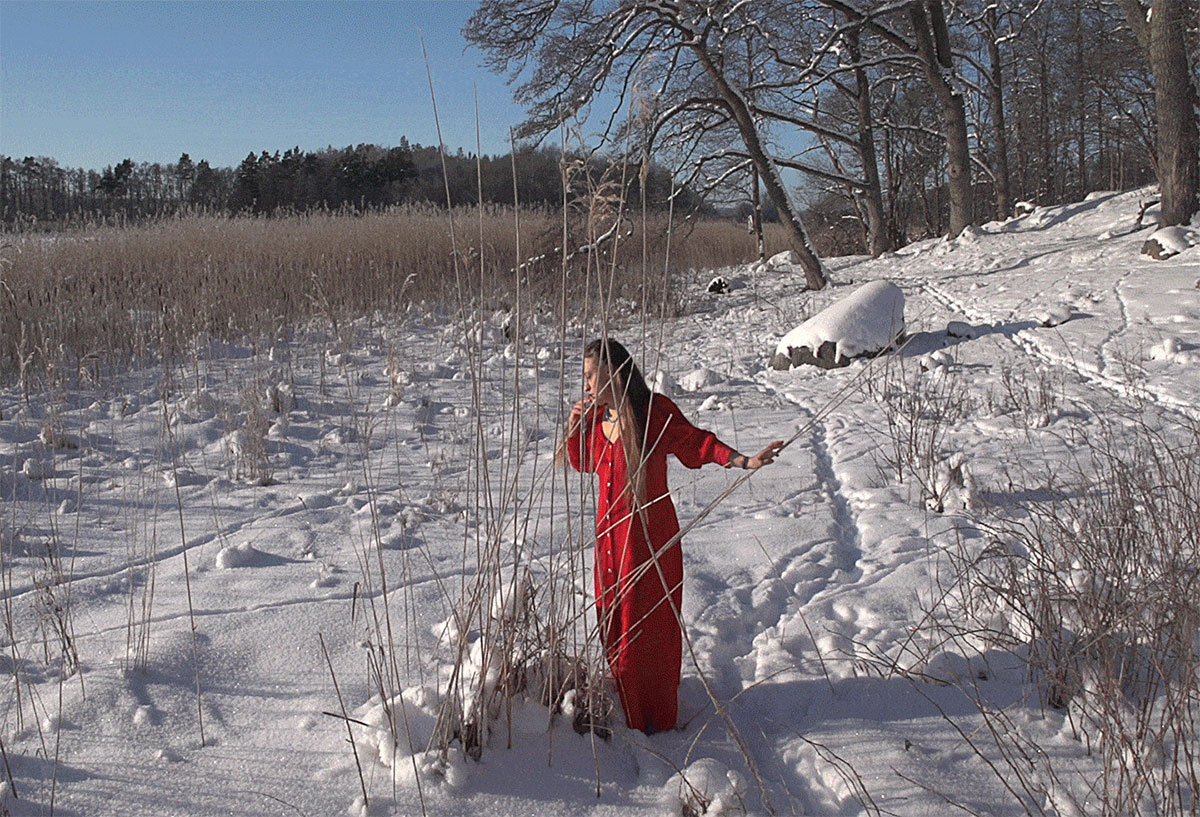 “Never Cross the Same River Twice” is a time-shifting survey of performances converging between video, film and installation. Initiated as a travelling research project in 2020, the fourth part of the exhibition traces the recent video practices of ten international artists selected by Kisito Assangni. The exhibition embraces expansive videographies that aim to foster new forms of transnational and collective assembly. The selected video works act as sites of visual contestation; cinematic aesthetics with narratives that re-remember; they reclaim histories and ancestries; decolonize both the mind and the imagination. Referencing Heraclitus’ river, which conceived identity as an ever-evolving and fluctuating entity, the title of the exhibition is a call to invent new grounds in place of entrenched environmental, political, and regulatory systems. Exploring the limits of film as activism, several of the participating works reflect what Walter D. Mignolo, termed the “epistemic disobedience and decolonial freedom” needed to rebuild just and non-colonial futures. From a “coming community” to a planetary escape, the exhibition opens up uncanny spectral exits to new geopolitical imaginaries. Info: Curator: Kisito Assangni, Troy House Art Foundation, 10-12 New Union Square, London, United Kingdom, Duration: 9/10-8/12/2023, Days & Hours: Mon-Fri 11:00-17:30, www.troyhouseart.org/
“Never Cross the Same River Twice” is a time-shifting survey of performances converging between video, film and installation. Initiated as a travelling research project in 2020, the fourth part of the exhibition traces the recent video practices of ten international artists selected by Kisito Assangni. The exhibition embraces expansive videographies that aim to foster new forms of transnational and collective assembly. The selected video works act as sites of visual contestation; cinematic aesthetics with narratives that re-remember; they reclaim histories and ancestries; decolonize both the mind and the imagination. Referencing Heraclitus’ river, which conceived identity as an ever-evolving and fluctuating entity, the title of the exhibition is a call to invent new grounds in place of entrenched environmental, political, and regulatory systems. Exploring the limits of film as activism, several of the participating works reflect what Walter D. Mignolo, termed the “epistemic disobedience and decolonial freedom” needed to rebuild just and non-colonial futures. From a “coming community” to a planetary escape, the exhibition opens up uncanny spectral exits to new geopolitical imaginaries. Info: Curator: Kisito Assangni, Troy House Art Foundation, 10-12 New Union Square, London, United Kingdom, Duration: 9/10-8/12/2023, Days & Hours: Mon-Fri 11:00-17:30, www.troyhouseart.org/
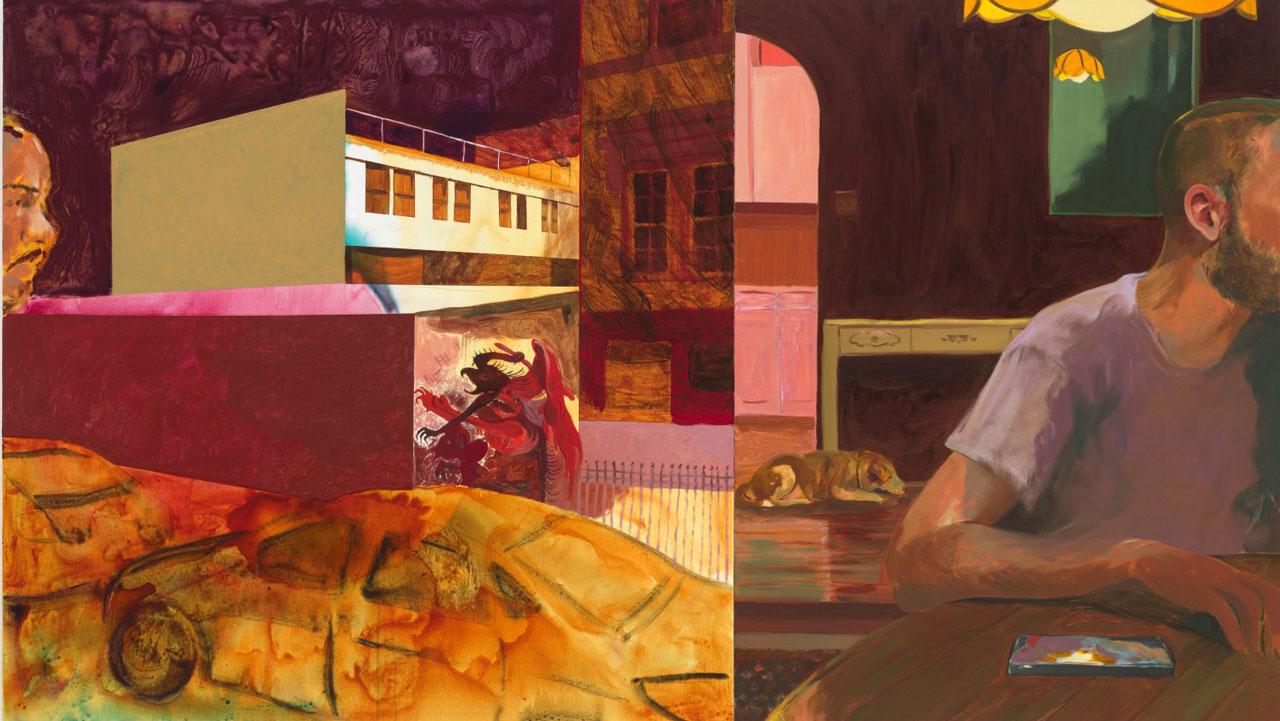 Anthony Cudahy is a painter whose tender scenes reveal the nuanced complexities of life. His work speaks to the legacy of figurative painting and portraiture, deftly combining historic references with contemporary life and human connection. Looking to allegorical paintings with multiple readings, motifs become a part of his visual lexicon, creating a world for stories. Marking Anthony Cudahy’s first solo project in the UK, a new body of work is on view in his dual exhibition “Double Spar”. The show takes its title, ‘Double Spar’, from an Icelandic sunstone which causes the sightline through the crystal to appear doubled. Interpreted in medieval texts as a celestial vision, the stone speaks to an early kind of magic, both symbolic and physical. Cudahy explores this idea of doubling: subtle dual associations appear in companion paintings, as recurrent gestures and pairings of figures. Mirroring is used as a compositional and narrative device to expand the material potential outside the space of the scenes. Repetitions of the same figure at different times of day within a painting evoke astral projections, and a meta exploration of time extends across both exhibition spaces through companion paintings. Info: GRIMM Gallery, 2 Bourdon Street, London, United Kingdom, Duration: 9/10-11/11/23, Days & Hours: Wed-Sat 11:00-18:00, https://grimmgallery.com/ & Hales Gallery, Tea Building, 7 Bethnal Green Road, London, United Kingdom, Duration: 9/10-11/11/23, Days & Hours: Wed-Sat 11:00-18:00, https://halesgallery.com/
Anthony Cudahy is a painter whose tender scenes reveal the nuanced complexities of life. His work speaks to the legacy of figurative painting and portraiture, deftly combining historic references with contemporary life and human connection. Looking to allegorical paintings with multiple readings, motifs become a part of his visual lexicon, creating a world for stories. Marking Anthony Cudahy’s first solo project in the UK, a new body of work is on view in his dual exhibition “Double Spar”. The show takes its title, ‘Double Spar’, from an Icelandic sunstone which causes the sightline through the crystal to appear doubled. Interpreted in medieval texts as a celestial vision, the stone speaks to an early kind of magic, both symbolic and physical. Cudahy explores this idea of doubling: subtle dual associations appear in companion paintings, as recurrent gestures and pairings of figures. Mirroring is used as a compositional and narrative device to expand the material potential outside the space of the scenes. Repetitions of the same figure at different times of day within a painting evoke astral projections, and a meta exploration of time extends across both exhibition spaces through companion paintings. Info: GRIMM Gallery, 2 Bourdon Street, London, United Kingdom, Duration: 9/10-11/11/23, Days & Hours: Wed-Sat 11:00-18:00, https://grimmgallery.com/ & Hales Gallery, Tea Building, 7 Bethnal Green Road, London, United Kingdom, Duration: 9/10-11/11/23, Days & Hours: Wed-Sat 11:00-18:00, https://halesgallery.com/
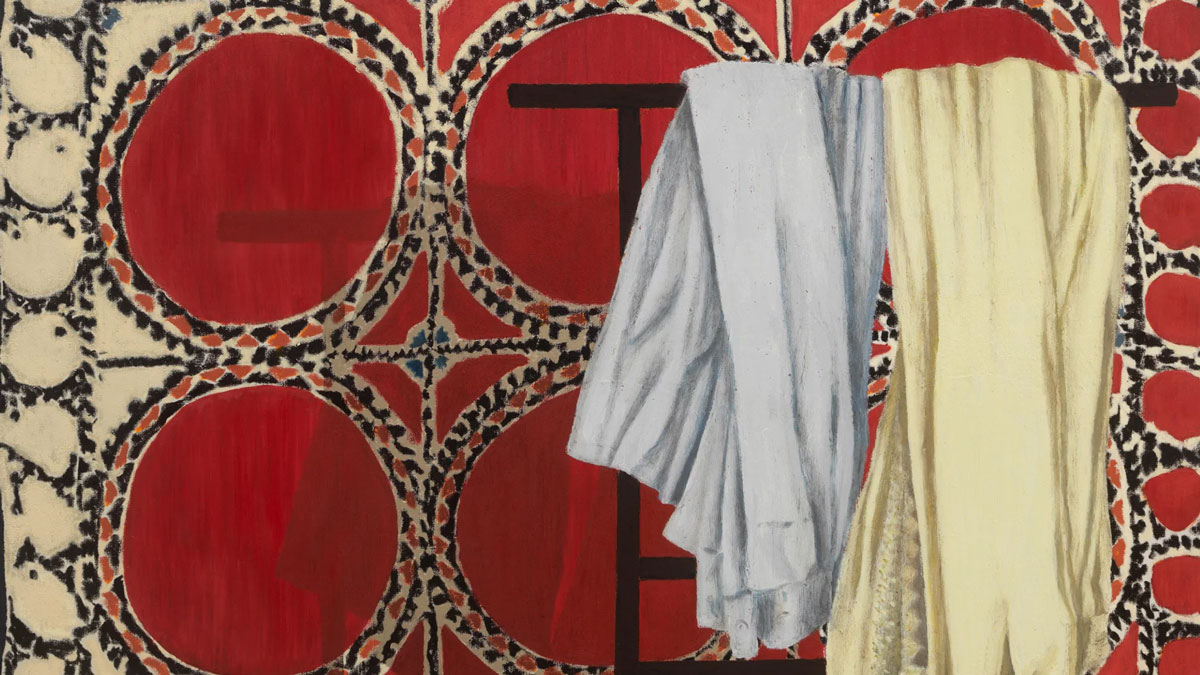 The works by Mamma Andersson in her solo exhibition “Adieu Maria Magdalena” consider recurring themes and motifs from her oeuvre and suggest complex and potent feelings related to loss. Marking a metaphorical farewell to a previous phase in her life, the exhibition title takes its name from a seventeenth-century church in the neighborhood where Andersson has long resided. The namesake painting portrays a screen divider with panels showing different views of uninhabited rooms; disembodied mannequin hands, a recurring motif for Andersson, are scattered at its base. Employing trompe l’oeil, the artist produces a subtly claustrophobic effect in this domestic space by layering uncanny interior scenes taken from her own home and her imagination, an interplay of surfaces and imagery that, like other works in the exhibition, probes the nature of representation. Departing from earlier oil-on-board works, the paintings on view primarily utilize canvas, a support that allows Andersson to create at a larger scale and expand compositional possibilities within the pictorial space. While these works evoke barren scenes by such artists as Vilhelm Hammershøi they are also touched by Andersson’s personal and private associations that capture a sense of domesticity and quietude. Info: David Zwirner Gallery, 108 Rue Vieille-du-Temple, Paris, France, Duration: 16/10-18/11/2023, Days & Hours: Tue-Sat 11:00-19:00, www.davidzwirner.com/
The works by Mamma Andersson in her solo exhibition “Adieu Maria Magdalena” consider recurring themes and motifs from her oeuvre and suggest complex and potent feelings related to loss. Marking a metaphorical farewell to a previous phase in her life, the exhibition title takes its name from a seventeenth-century church in the neighborhood where Andersson has long resided. The namesake painting portrays a screen divider with panels showing different views of uninhabited rooms; disembodied mannequin hands, a recurring motif for Andersson, are scattered at its base. Employing trompe l’oeil, the artist produces a subtly claustrophobic effect in this domestic space by layering uncanny interior scenes taken from her own home and her imagination, an interplay of surfaces and imagery that, like other works in the exhibition, probes the nature of representation. Departing from earlier oil-on-board works, the paintings on view primarily utilize canvas, a support that allows Andersson to create at a larger scale and expand compositional possibilities within the pictorial space. While these works evoke barren scenes by such artists as Vilhelm Hammershøi they are also touched by Andersson’s personal and private associations that capture a sense of domesticity and quietude. Info: David Zwirner Gallery, 108 Rue Vieille-du-Temple, Paris, France, Duration: 16/10-18/11/2023, Days & Hours: Tue-Sat 11:00-19:00, www.davidzwirner.com/
